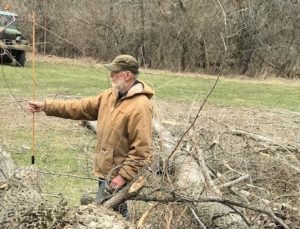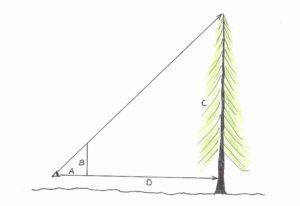The Magic Measuring Stick
Sometimes when you fell a tall tree, you want to know how far from the stump it will reach. Will it hit the neighbor’s house? Will it land on your fence? If you are correcting a bad lean with a long rope or chain, will it hit the truck that is pulling? Will the top land on the highway? You can answer these questions by making a magic measuring stick and learning how to use it. This photo and illustration show the basics, followed by a how-to-do-it narrative:

How to hold the measuring stick.

Schematic of the geometry of sighting the stick .
Select a straight slender stick about four feet long (mine is a 3/8 inch dowel). Attach a small weight symmetrically to the bottom end to help you hold it vertically.
Holding your hand at horizontal arm’s length fully extended, measure the distance from your sighting eye to the crotch of your thumb and forefinger (“A” on the sketch). Mark this distance down from the top of your stick and, in use, hold the stick with this mark at the top of your hand (“B” on the sketch).
To use the stick to measure falling distance, take a guess at the top’s reach and then shuffle yourself around until the top of the stick is at the top of the tree, and the top of your hand is at the top of the future stump. When these both match up, you are standing where the treetop will reach when felled.
The way that the geometry works out is that up close, the length of your arm, the length of the stick above your hand, and your line of sight form a 45° x 45° x 90° triangle, because you made the horizontal leg and the vertical leg equal. Then by walking back and forth to match the top and bottom of the tree to your stick length, you have found the magic spot where those angles are duplicated on a large scale; where the vertical tree height matches your horizontal distance from it. Expressed on the sketch above, its where A=B and C=D.
When I can clearly see the top of the tree, my experience is that this method proves accurate to within about five feet. In a tall leafy tree in summer, I wind up looking through the leaves and guessing at the very top and my accuracy can drop to 8-10 feet.
Holding the stick vertically is important and attaching a little weight to the bottom will help it behave like a plumb bob and improve accuracy. The geometry works out best on fairly level ground.
While it is simple to make a measuring stick at home where tools are handy, one can also be improvised in the field from a straight walking stick or sapling. For the eye-to-hand distance, just hold the stick out along your extended arm for a moment, being careful to not poke yourself in the eye, and then mark the distance to your hand with a notch made with your pocketknife.
Recently my neighbor was planning to fell a tall tree leaning toward his house, using a long cable attached to his truck to direct the fall in the opposite direction. He asked me about a safe distance for the truck. So we both used my magic stick, recalibrating it for his eye-to-hand distance, and we both flagged our distances, which were separated for about five feet. The tree top landed between the flags.
You need to test your own accuracy before employing it in a demanding situation. When I was a Boy Scout, my first test was to measure against a fifth floor windowsill of a building, then run a long tape measure down from that window, and then compare to where I had been standing from the building when C=D. The Boy Scout motto is be prepared, and keeping my magic stick handy in the closet has served me well on occasion.
It is important to duplicate your chosen pose each time you use it – same eye, same hand, arm fully extended, and stick vertical.


